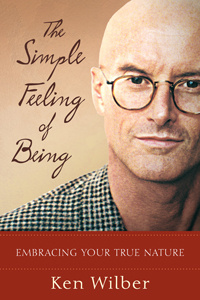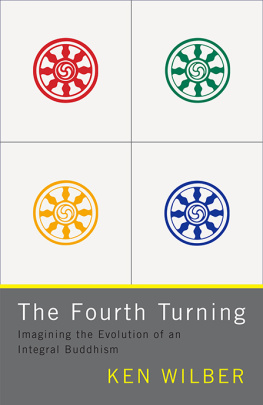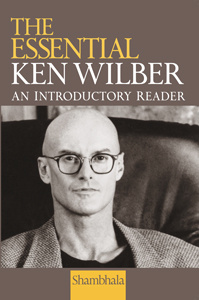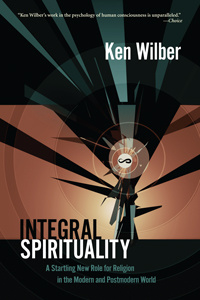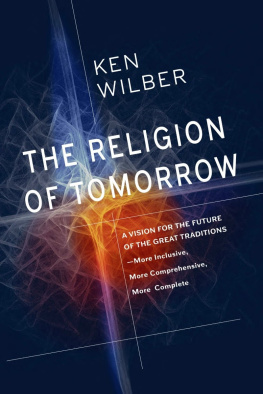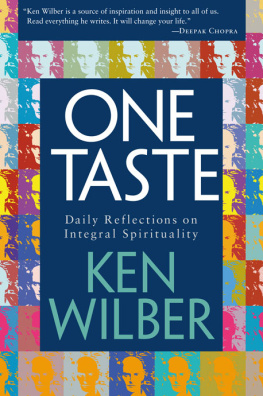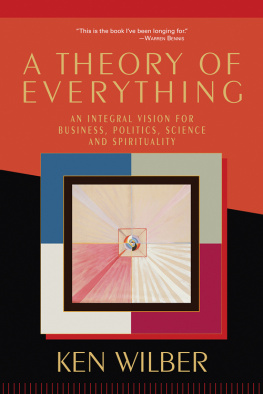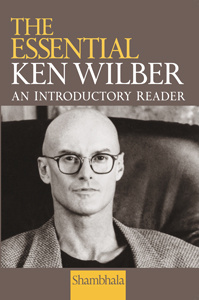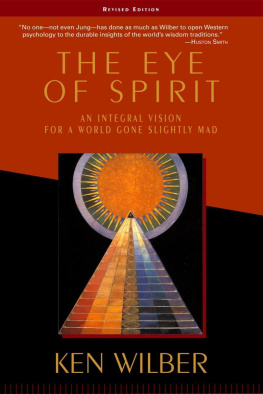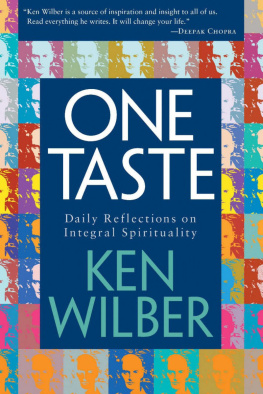
Integral Books publishes todays finest writers and thinkers addressing the full spectrum of human activityfrom business to psychology, spirituality to medicine, education to politics, art to ecologywith a comprehensive approach that encompasses body, mind, and spirit in self, culture, and nature. Rooted in the pioneering work of series editor Ken Wilber and his Integral Institute, these works of scholarship, nonfiction, and literature are designed to awaken, inspire, and liberate.
Integral
Spirituality
A Startling New Role for Religion in the Modern and Postmodern World
Ken Wilber

Integral Books
Boston & London
2011
Integral Books
An imprint of Shambhala Publications, Inc.
Horticultural Hall
300 Massachusetts Avenue
Boston, Massachusetts 02115
www.shambhala.com
2006 by Ken Wilber
Cover art by Joel Morrison and Learned Evolution.
Excerpts from Mind at Ease: Self-Liberation through Mahamudra Meditation by Traleg Kyabgon, 2003, reprinted by arrangement with Shambhala Publications, Inc.
by John Chirban reprinted from Transformations of Consciousness: Conventional and Contemplative Perspectives on Development by Ken Wilber, Jack Engler, and Daniel P. Brown, 1986, reprinted by arrangement with Shambhala Publications, Inc.
All rights reserved. No part of this book may be reproduced in any form or by any means, electronic or mechanical, including photocopying, recording, or by any information storage and retrieval system, without permission in writing from the publisher.
The Library of Congress catalogues the previous edition of this book as follows: Wilber, Ken.
Integral spirituality: a startling new role for religion in the modern and postmodern world / Ken Wilber.1st ed.
p. cm.
Includes index.
eISBN 978-0-8348-2244-3
ISBN 978-1-59030-346-7 (hardcover: alk. paper)
ISBN 978-1-59030-527-0 (paperback)
1. Spirituality. 2. Consciousness. I. Title.
BL624.W533 2006
204dc22
2006001082
To Colin Bigelow
Manjushri to Vajrapani, some might say
I N THE PAST TWO DECADES, a radically new theoretical framework for organizing the world and activities in it has started to achieve prominence and widespread recognition. Known as the Integral Approach, it has been used in everything from business to medicine, psychology to law, politics to sustainability, art to education. Because the Integral Framework claims to be comprehensive or inclusive, each discipline using it has been able to reorganize itself in more comprehensive, effective, efficient, and inclusive ways. The Integral Approach itself does not add any content to these disciplines; it simply shows them the areas of their own approaches that are less than integral or less than comprehensive, and this acts as a guide for reorganizing the disciplines in ways that are proving to be, in some cases, nothing less than revolutionary.
What if the Integral Approach were applied to spirituality? That is the topic of this book.
The very nature of this topic is so serious, so somber, and the ramifications so monumental in reach and scope, that I didnt want the tone of this book itself to suffocate in seriousness. I therefore chose a tenor that in some cases might appear to have gone too far in the other direction, toward lightness and even frivolity. But I think this is the only way to proceed with a topic that involves nothing less than ultimate concern about issues such as God and Spirit, redemption and release, sin and salvation, illusion and waking up. Lightness of touch is the wiser tone, and luminosity a grace.
One of the main difficulties in presenting the Integral Approach is that you have to explain it before you can apply it. So I have included, as a type of prologue or prelude, a 32-page overview called Introduction: The Integral Approach. Those of you familiar with the Integral Approach can of course skim through this or skip it altogether.
After the Integral Approach is briefly introduced and explained, it is applied to spirituality. I wont give a summary of the conclusions this book reaches, but simply point out that it addresses perhaps 4 or 5 of the most pressing issues facing spiritualitysuch as applying spirituality in everyday life, proof of Spirits existence, stages of spiritual development, the role of meditation or contemplation, Eastern and Western approaches to religionand their relation to currents in the modern and postmodern world. The result is what amounts to a manifesto for an Integral Spirituality.
I do believe that an integral approach to spirituality discovers a role for religion in the modern and postmodern world that has been overlooked entirely, and this radically new role for religion not only works, it holds a very real type of salvation for humanity on the whole. Exactly what this role is will be explained as the discussion unfolds.
There are several footnotes in the book, and, for those who would like to go into these issues in more depth, on the www.kenwilber.com and wilber.shambhala.com websites, you will find hundreds of pages of endnotes. Throughout this book you will also notice mention of Excerpts AG. These are excerpts from volume 2 of the Kosmos Trilogy (vol. 1 of which is Sex, Ecology, Spirituality). These Excerpts are also posted on the www.kenwilber.com and wilber.shambhala.com sites.
In the following pages, when writing about the Integral Approach, I often use the pronoun we instead of I. This we refers to the colleagues at Integral Institute (I-I), and I use we in describing this work because it really is a joint effort of hundreds of individuals who are immediately involved as staff at Integral Institute (and tens of thousands who are members of I-I), dedicated to bringing a more integral approach to all walks of life. Several times throughout this book you will be invited to join us (www.integralinstitute.org) if you would like to help with this extraordinary adventure.
Its a new day, its a new dawn, its a new man, its a new woman. The new human is integral, and so is the spirituality.
K.W.
Denver, Colorado
Spring 2006
The Integral Approach
Overview
During the last 30 years, we have witnessed a historical first: all of the worlds cultures are now available to us. In the past, if you were born, say, a Chinese, you likely spent your entire life in one culture, often in one province, sometimes in one house, living and loving and dying on one small plot of land. But today, not only are people geographically mobile, but we can study, and have studied, virtually every known culture on the planet. In the global village, all cultures are exposed to each other.
Knowledge itself is now global. This means that, also for the first time, the sum total of human knowledge is available to usthe knowledge, experience, wisdom, and reflection of all major human civilizationspremodern, modern, and postmodernare open to study by anyone.
What if we took literally everything that all the various cultures have to tell us about human potentialabout spiritual growth, psychological growth, social growthand put it all on the table? What if we attempted to find the critically essential keys to human growth, based on the sum total of human knowledge now open to us? What if we attempted, based on extensive cross-cultural study, to use all of the worlds great traditions to create a composite map, a comprehensive map, an all-inclusive or
Next page
